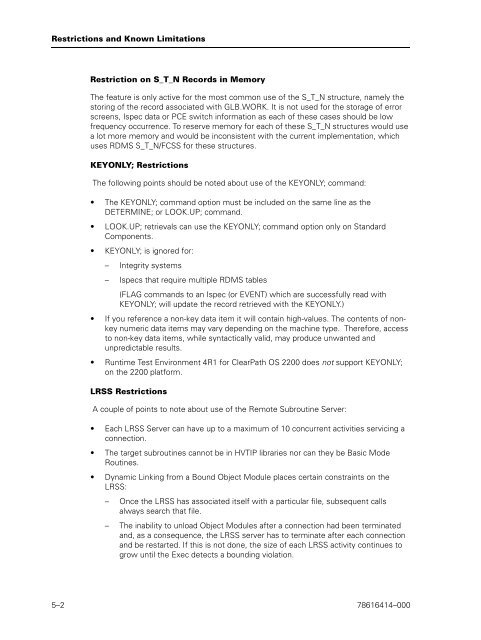Runtime for ClearPath OS 2200 Software Release Announcement
Runtime for ClearPath OS 2200 Software Release Announcement
Runtime for ClearPath OS 2200 Software Release Announcement
Create successful ePaper yourself
Turn your PDF publications into a flip-book with our unique Google optimized e-Paper software.
Restrictions and Known Limitations<br />
Restriction on S_T_N Records in Memory<br />
The feature is only active <strong>for</strong> the most common use of the S_T_N structure, namely the<br />
storing of the record associated with GLB.WORK. It is not used <strong>for</strong> the storage of error<br />
screens, Ispec data or PCE switch in<strong>for</strong>mation as each of these cases should be low<br />
frequency occurrence. To reserve memory <strong>for</strong> each of these S_T_N structures would use<br />
a lot more memory and would be inconsistent with the current implementation, which<br />
uses RDMS S_T_N/FCSS <strong>for</strong> these structures.<br />
KEYONLY; Restrictions<br />
The following points should be noted about use of the KEYONLY; command:<br />
• The KEYONLY; command option must be included on the same line as the<br />
DETERMINE; or LOOK.UP; command.<br />
• LOOK.UP; retrievals can use the KEYONLY; command option only on Standard<br />
Components.<br />
• KEYONLY; is ignored <strong>for</strong>:<br />
– Integrity systems<br />
– Ispecs that require multiple RDMS tables<br />
(FLAG commands to an Ispec (or EVENT) which are successfully read with<br />
KEYONLY; will update the record retrieved with the KEYONLY.)<br />
• If you reference a non-key data item it will contain high-values. The contents of nonkey<br />
numeric data items may vary depending on the machine type. There<strong>for</strong>e, access<br />
to non-key data items, while syntactically valid, may produce unwanted and<br />
unpredictable results.<br />
• <strong>Runtime</strong> Test Environment 4R1 <strong>for</strong> <strong>ClearPath</strong> <strong>OS</strong> <strong>2200</strong> does not support KEYONLY;<br />
on the <strong>2200</strong> plat<strong>for</strong>m.<br />
LRSS Restrictions<br />
A couple of points to note about use of the Remote Subroutine Server:<br />
• Each LRSS Server can have up to a maximum of 10 concurrent activities servicing a<br />
connection.<br />
• The target subroutines cannot be in HVTIP libraries nor can they be Basic Mode<br />
Routines.<br />
• Dynamic Linking from a Bound Object Module places certain constraints on the<br />
LRSS:<br />
– Once the LRSS has associated itself with a particular file, subsequent calls<br />
always search that file.<br />
– The inability to unload Object Modules after a connection had been terminated<br />
and, as a consequence, the LRSS server has to terminate after each connection<br />
and be restarted. If this is not done, the size of each LRSS activity continues to<br />
grow until the Exec detects a bounding violation.<br />
5–2 78616414–000
















